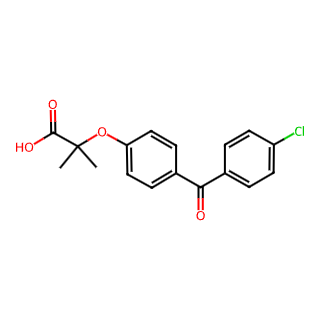- Synthetic anti-infective drugs
- Medications for the digestive system
- Antipyretic and analgesic drugs
- Medications for the blood system
- Medications for the respiratory system
- Anti-allergic drugs
- Medications for the urinary system
- Diagnostic medications
- Immunosuppressive and immunomodulatory drugs
- Vitamins and mineral supplements
- Antioxidants and medications for osteoporosis
- Antiparasitic drugs
- Ophthalmic medications
- Amino acids and their derivatives
- Dermatological medications
- Medications for the circulatory system
- Antitumor drugs
- Medications for the nervous system
- Hormonal and endocrine function-regulating drugs
- Antibiotics
- Others
CAS NO.: 42017-89-0




Basic Information
English Name: Fenofibric acid
CAS Number: 42017-89-0
Molecular Formula: C17H15ClO4
Molecular Weight: 318.75 (or 318.76, slight variations may exist from different sources)
EINECS Number: 255-626-9
Melting Point: Approximately 177-179°C (or 182-184°C, slight variations may exist from different sources)
Boiling Point: 486.5±35.0 °C (predicted)
Density: 1.286±0.06 g/cm3 (predicted)
Solubility: Soluble in chloroform (slightly), methanol (slightly)
pKa: 3.09±0.10 (predicted)
Biological Activities and Pharmacological Effects
Lipid-Lowering Effect: Fenofibric acid is the active metabolite of fenofibrate, which exhibits lipid-lowering properties, particularly in reducing low-density lipoprotein cholesterol (LDL-C) and triglyceride (TG) levels.
PPAR Agonist: Fenofibric acid acts as an agonist for peroxisome proliferator-activated receptors (PPARs), with EC50 values of 22.4µM, 1.47µM, and 1.06µM for PPARα, PPARγ, and PPARδ, respectively.
Anti-inflammatory Effect: In animal experiments, Fenofibric acid has shown anti-inflammatory activity, inhibiting acute inflammation induced by carrageenan.
Other Effects: Fenofibric acid also inhibits COX-2 activity, suggesting potential antitumor and other biological activities.
Uses
Pharmaceutical Intermediate: Fenofibric acid is primarily used in the pharmaceutical industry as an intermediate for the synthesis of lipid-lowering drugs, particularly fenofibrate.
Clinical Application: Although Fenofibric acid itself may not be directly used as a medication, its parent compound, fenofibrate, is widely prescribed for the treatment of hyperlipidemia and other lipid disorders.
Storage and Transportation
Storage Conditions: Fenofibric acid should be stored at 2-8°C to maintain its stability and activity.
Hazardous Information: Fenofibric acid is considered hazardous and should be stored and transported according to relevant regulations. Hazard symbols such as Xn and N may apply, and safety precautions should be taken during transportation.

Tai Yau Street, San Po Kong, Kowloon, Hong Kong, China.



